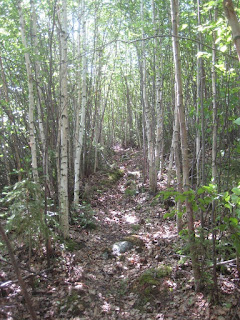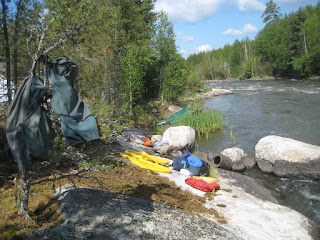Arising by 3:30 am on June 23 to break camp 8, the blackflies are very bothersome so I do not have breakfast until I reach a small island after travelling about one km.
Approaching the next portage, the shoreline is quite high and steep, sometimes almost vertical. It is a good thing that I stopped for camp 8 when I did, as the five km after that does not appear to have any good campsites. When I land at the head of the rapids on the left side, I pick a serving of fireweed shoots and leaves before I haul the canoe over them. I often pick one or two salads while portaging as when I make camp sometimes there is nothing available.
As soon as I land, I can see that the portage trail needs clearing so the tools come out right away. The trail rises at a 30° angle through trees and then levels off across the side of a mostly bare rock face. At one point I place felled pine and spruce along the very steep rock slope to form a "bridge" of sorts on which to walk. It takes three hours to clear the overgrown 470 metre trail of small pine, spruce, birch and alder.
From the side of the rock face there is a good view of the deep gorge and rapids below. It is obvious that the rapids are unrunnable.
The trail meanders up and down some steep knolls through lots of birch trees that have grown back after the last forest fire at least 20 years ago.
At 330 metres the trail gets mean and drops downhill 70 metres on a very steep 60° slope. After clearing the entire portage, I carry all the gear to the top of the hill in the usual six loads.
I carry all the gear down the steep hill, taking seven trips instead of six as it is not safe to carry any packs on top of other packs. Carrying one pack on my back and another load in my left hand, I utilize my right hand to hang onto birch trees at the side of the trail, which are also used to anchor my feet going down the hill. Portaging down is hard, but I do not look forward to the return uphill trip. It is not possible to carry the canoe down, so I slide and lower it using the rope painter. However, when the canoe reaches the turn midway it is stuck and I have to go below to pull it the rest of the way.
The last 70 metres at the lower end of the trail is the only level spot on the portage, in a stand of birch ending in a grassy open area at the rocky shore with many large boulders. There are a few gulls and about 30 terns continuously flying and diving to feed from the river surface. Sweaty from clearing the trail, and sweat-soaked after the portage, I stop for a well deserved rest and lunch at the foot of the portage in the shade of several large spruce trees.
Proceeding two km down the river, I reach the next rapids where I land on the right to investigate. The rapids seem runnable, but for my return trip I will need to portage, so I need to find a trail. There is nothing on the right hand side, and appears too steep to cut a trail, so I canoe across to the left side and walk to the lower end of the rapids through the bush near shore. There appears to be a very old completely overgrown trail. I check below the rapids for a campsite but there is nothing suitable so I return to the head of the rapids and find an acceptable spot. I have travelled nine km, including the 470 metre portage.
A beaver along the shore grooming herself, shows up near camp each day I am here.
There is a good spot for a fireplace and halfway up the hill a place for the tarp shelter.
Three fried walleye and potato flakes with a salad of fireweed and "green" red currants. I always give thanks for the fish and salad. The fishing is good from shore at the foot of the rapids, and at one place near the top of the rapids.
At the top of the hill, there is a somewhat level spot for the tent that requires a significant amount of clearing as can be seen by the pile of felled trees behind the tent.
On the second day, I cut an 170 metre portage trail that starts right behind the fireplace. The trail appears to be over an old one as I did see a few saw cuts, but it still took two hours of saw, pruners and axe work. The horseflies are buggers each day all day long, biting hard. Blackflies and mosquitoes are bothersome. When I have a bath, the horseflies are bad, so they sure prompt fast bathing and dressing.
On the third day, I arise at 3:30 am and head downstream after my usual cold breakfast when travelling. Choosing to run the 500 metre rapids, I do not need to portage until I am on my return voyage. However, the canoe grounds on an unseen boulder midstream. Aie! The "sticky" aluminum and the protruding keel prove my demise. I have grown to used to the Clipper canoe which would have slid over the boulder. I think I can shove off the boulder but in trying to do so the canoe turns sideways and before I can do anything more, it tips sideways and fills with water. Aie, aie, aie! (My exact words at the time were probably stronger.) Managing to force the canoe off the boulder I float backwards down the rapids and paddle the water-filled canoe close to shore about 500 metres below the rapids. The only gear lost is a sponge. All other gear was strapped in and the canoe floated well even though full of water. Thank goodness I had my PFD on as it definitely helped float me up as the canoe tipped sideways. I am soaked but unharmed except for scrapes on the back of my hands which must have occurred when pushing off from the boulder. Wading into the river, I unload all the gear onto shore. Pulling the canoe towards land, I flip the canoe to empty the water. Once turned upright, I can see that the bottom of the canoe is buckled inwards a bit, so I stomp it straight. Emptying the packs of the bulk of their water, I reload the canoe and paddle back to the lower end of the rapids at my new portage trail. Aie! By the time I get to shore, there are several more litres of water in the bow of the canoe so I know there is a leak. Aie! Unloading the gear, I carry it to the campsite at the upper end of the rapids, back to camp 9 after the shortest canoe trip ever. Aie!
When I haul the canoe on shore and overturn it, I see the reason for the extra water. The front keel has a hole about the diameter of my thumb in the patch cement which was added the last time I stored the canoe 10 years ago after 30 years of use. Aie! Not good! In my Repair Kit I have a "hot melt glue stick" that a friend Jean gave to me many years ago to put in the kit, but never used. I also have a "blowtorch" lighter that another friend Omar gave to me that I have occasionally used to start a fire in very difficult conditions. Using the lighter I melt the glue stick into the hole. When the hole is full, I use multiple layers of Cantech® duct tape over the wound. The hot sun and 31℃ temperature helps stick it firmly in place. Thanks to Jean and Omar! I say a prayer to the canoe gods to make this patch work. I will find out tomorrow when I move on.
At camp (below), I empty all the packs to dry gear and grub. The barrel and most packs with waterproof bags contain no water. However, the month two food bag let in some water. A little bit of water goes a long way. Aie! Mostly the Ziploc® bags are only wet on the outside, but some let water in the top seal and those I open and dry or replace. Most items are in at least two sets of bags. (The replacement bags are those I save during the trip as they are emptied.) Luckily, the sky is clear and sunny and moisture soon evaporates. All outer packs and bags are hung to dry as well any damp contents of those with no inner waterproof bag. My belt gear was submerged with me so needs drying too. From my journal: "A LOT of work. But ... all's well that ends well. Main thing is no gear lost and not much physical injury to me. Could have been much worse." A snowshoe hare runs directly through camp while I am drying gear, as if to say "I thought you were moving on." Yeah ... well I was ... but ....






































































